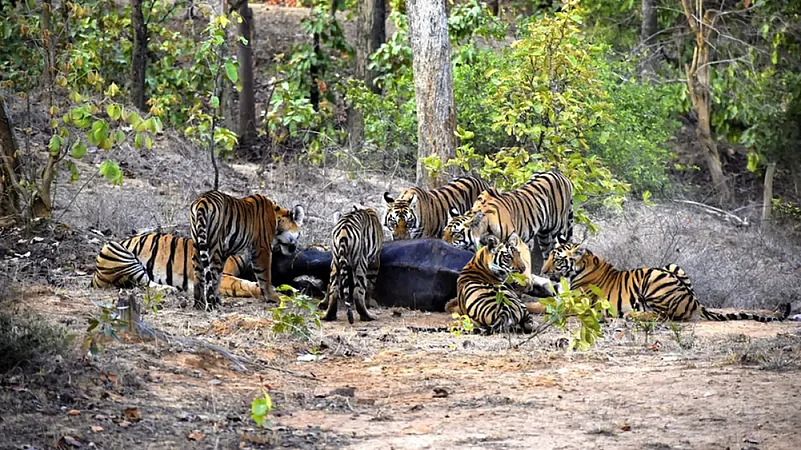The Andhra Pradesh forest department is yet to reunite the four abandoned tiger cubs found in a village in Nandyala district with the mother, an official said on Wednesday. The 48-hour timeline crucial for the tigress to accept or reject the litter has lapsed. However, the all-female litter is doing fine and active, while the search for the mother continues.“We have a brief idea as to where the mother is with the recent pug marks but we don’t know the exact pinpoint location,” said Allen Teron, deputy director, Atmakur, Wildlife Division, Nagarjunsagar Srisailam Tiger Reserve (NSTR).
AP Forest Dept Yet To Reunite Cubs With Mother
The Andhra Pradesh forest department is yet to reunite the four abandoned tiger cubs found in a village in Nandyala district with the mother, an official said on Wednesday.

He said the department will search until it receives further orders as the timeline has lapsed. In the event, the mother does not own up its litter, the department will follow the protocol laid down by the National Tiger Conservation Authority (NTCA) in handling orphaned or abandoned cubs. Arrangements to shift the cubs to a zoo are also on standby since Tuesday while officials are feeding Royal Canin, a zero sugar feed usually given to canines in the zoos. Some experts have also suggested feeding the cubs with a mix of goat milk and mashed chicken liver.
Other supplements such as ORS and water are also being fed to the cubs following zoo protocol to avert dehydration, which the cubs are taking orally. According to officials, sugar must not be fed to the cubs as they cannot process glucose like humans or domestic cats and dogs used to it. As a standard practice sugar is not fed to wild cats. Tiger experts have estimated the age of the cubs to be three months, even as an NTCA nominee has joined the team. The officials are also discussing the situation with experts from other tiger reserves. The forest department has released a couple of videos showing the cubs drinking water and veterinarians tending to them, including checking their temperature.
NSTR happens to be one of the largest tiger reserves in the country, stretching over 6,000 sq km in five districts and hosting a rich biodiversity of fauna and flora. Of the total area, the core tiger habitat stretches up to an area of 3,721 sq km, padded by a buffer zone of 2,216 sq km, filled with deep valleys, gorges, ridges, plateaus and tropical dry deciduous wilderness, including bamboo and grass cover. Rajiv Gandhi Wildlife Sanctuary, the core area of the reserve has open and closed forests while the southern section has luxuriant forests, including grass savannas along the Krishna river gorges.
Likewise, the buffer zone has a few villages and several more in its periphery facing human – wildlife interfaces. Heavily used public infrastructure such as roads, markets and power lines also pass through it.
- Previous Story
 Elections 2024: Ashok Tanwar Joins Congress Again; Sehwag Endorses Congress Candidate In Haryana
Elections 2024: Ashok Tanwar Joins Congress Again; Sehwag Endorses Congress Candidate In Haryana - Next Story
























